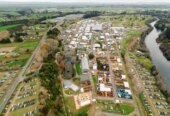The installation and blessing of what is thought to be Kihikihi’s first Māori street sign was a “momentous occasion”.
“I think until we were standing there on that morning, the penny hadn’t dropped of how significant it was,” said Kate Searancke, who represents Ngāwaero, hapū of Ngāti Maniapoto, on Ngā Iwi Tōpū O Waipā (Nitow).
Te Koko Lane is a new subdivision at 93 Whitmore Street in Kihikihi. Its sign was installed last Wednesday and was blessed by the Waipā District Council’s iwi relations advisor Shane Te Ruki.

Kate and Kiwi Searancke celebrate Te Koko Lane.
Kate Searancke said the sign’s name represents the functionality of Nitow and the hard work of those who fought for Māori consultation in the district.
“It was a significant moment to stand there and feel the depth of that hard work,” said Kate.
The name for Te Koko Lane was approved by the district council after developers consulted with Kate and Nitow earlier this year.
Kate, 41, said her grandfather George Searancke, 93, suggested the name to her as Te Koko is the surname of her great great grandmother, Ngāwaero Te Koko, who shares the name with their hapū.
When the Resource Management Act came into effect in 1991, developers were required to consult with mana whenua about projects.
In Waipā, resource consent applications lodged with the council are forwarded to hapū and iwi representatives on Nitow for consultation.
Kate’s father, Waikato rugby legend Kiwi Searancke, said George (his father) and brother Monty Searancke alongside others including Harold Maniapoto, pushed for the council to set up an iwi consultative committee to formalise that process of iwi consultation.

Father and daughter, Kiwi and Kate Searancke. Photo: Benjamin Wilson
“They had great mayoral support, which I guess gave it the right push from council. They won a few battles, they lost a few battles, but they just stayed in there and kept getting the respect that they’ve now gained over 30 years.”
Waipā was the first district in New Zealand to form an iwi consultation committee.
“It was so clever, what it did is it actually ensured that consultation happened,” said Kate.
“In other districts, developers have to figure out who to consult with, and you don’t always know who has the mana over a particular whenua as developer, so it can be quite tricky to figure out who to consult with. Because of what has been created in Waipā, it is a much easier process, and this sign means that change is happening.”
Kate took over her grandfather’s place on Nitow five years ago, when he was diagnosed with early dementia.
“He knew that he couldn’t carry on, under normal circumstances he would have asked me if I would take his place, but when we chatted, I said because I was nearly 70, it is going to be a short-term thing,” said Kiwi.
“We needed to think long-term, that is why he suggested that Kate do It.”
“It is quite a responsibility to have taken over Pop’s role on that committee and then have someone ask you to name a street,” said Kate.
“I am of a generation where it (Māori representation) is now celebrated; I am aware that a lot of the hard work that was put in happened in a time when it wasn’t.”
“This was not a privilege but an honour, and I pay homage to my Pop who, in his own quiet way, fought for the right to see the names of our tūpuna amongst the Whittakers, the Greys and the Rollestons,” Kate wrote in an online post.









